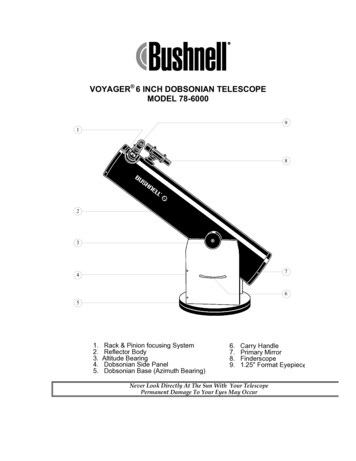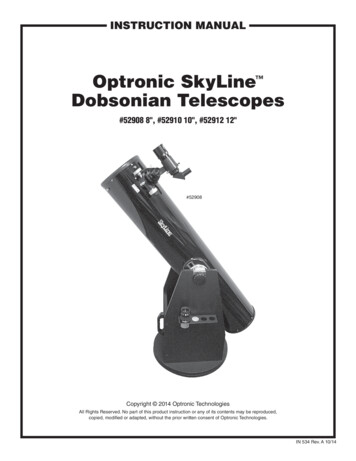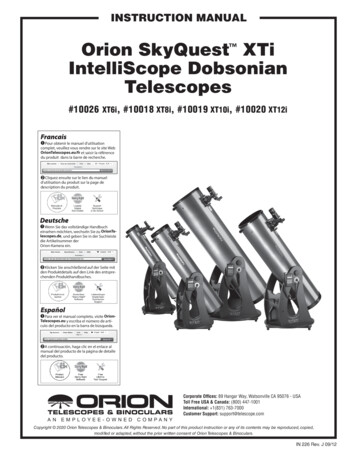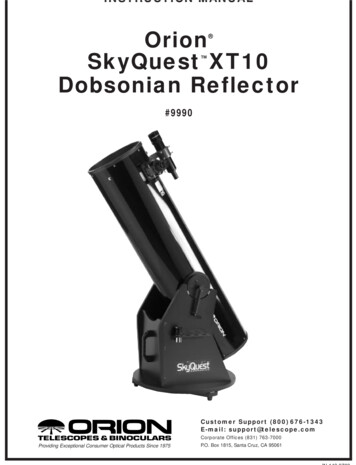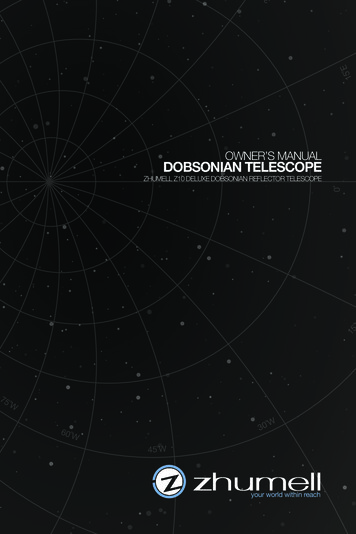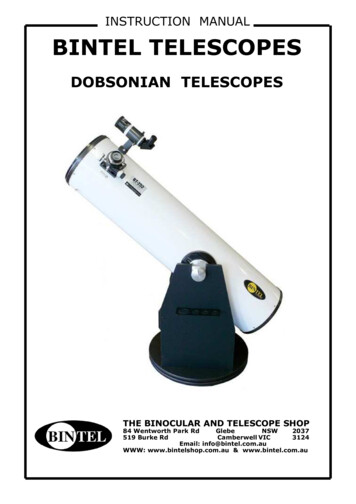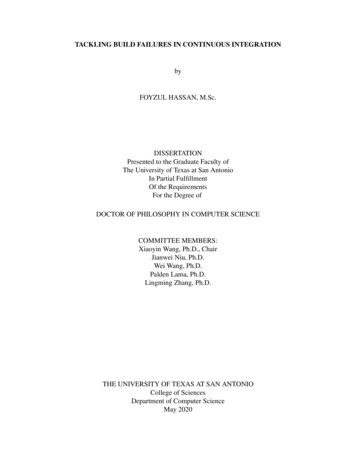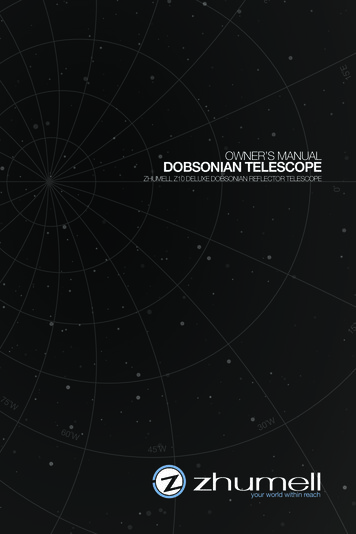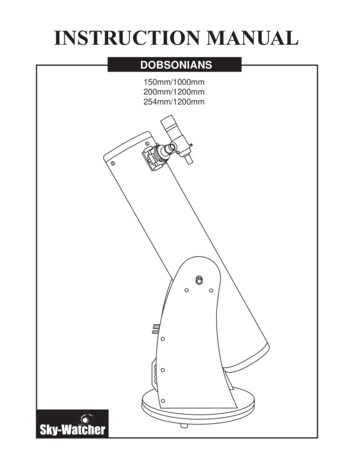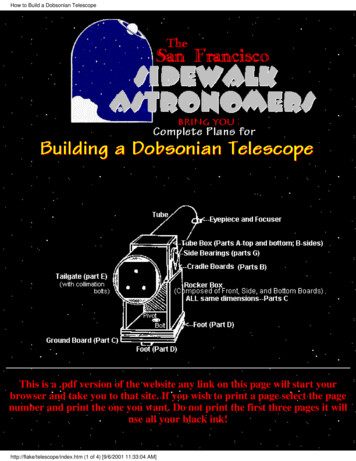
Transcription
How to Build a Dobsonian TelescopeThis is a .pdf version of the website any link on this page will start yourbrowser and take you to that site. If you wish to print a page select the pagenumber and print the one you want. Do not print the first three pages it willuse all your black ink!http://flake/telescope/index.htm (1 of 4) [9/6/2001 11:33:04 AM]
How to Build a Dobsonian TelescopeThis manual was created using Acrobat 4.0 you need to download the latestfree reader to view this manual properly! Older readers will give you strangeresults.TABLE OF CONTENTSIntroduction and Photo of Completed 'Scope"Not-too-tech advice"; Materials List; Tool List;Sources ListOverview Drawing of Six-inch 'Scope with PlywoodCut PatternOverview Drawing of Eight-inch 'Scope withPlywood Cut PatternOverview Drawing of Ten-Inch 'Scope with PlywoodCut PatternSection "A": Preparing the Tube, Making "Spider";Eyepiece TubeSection "B"; "Tailgate" (Mirror Cell) ConstructionSection "C"; Making the Mount; Finishing Tips; CareInstructionsFrequently Asked Questionshttp://flake/telescope/index.htm (2 of 4) [9/6/2001 11:33:04 AM]
How to Build a Dobsonian TelescopeE-mail:To my other WebPages:My Vanity PageMy Deep-Sky PageHow to Build a 13" Travel ScopeDobsonian EvolutionThe San Francisco Sidewalk AstronomersMy Fastar CCD PageRay Cash-Le PennecThis site is a member of theAmateur Telescope Making Web RingPrevious 5 Previous Random List Next Next 5Visitors since March 29, 1998http://flake/telescope/index.htm (3 of 4) [9/6/2001 11:33:04 AM]
Dobsonian Telescope PlansPlans for Building a Dobsonian Telescopebrought to you by: The San Francisco Sidewalk AstronomersYes, it "looks like a cannon," but the above is really a ten-inch (measured by the diameter of theobjective) Newtonian telescope that almost anybody can build. Here you will find plans to build thistelescope, or a smaller one--either a six-inch, or an eight-inch--of identical design. These plans are onlyslightly modified from the plans The Sidewalk Astronomers have been sending to interested parties for amere 2.00 via snail-mail. I have kept as close to this design as possible: One, because this is--handsdown--the cheapest and easiest way to make a quality telescope; and two, because I walk in the shadowof John Dobson, who invented many of these designs which have revolutionized amateur andprofessional astronomy alike. Besides, Los Angeles Sidewalk Astronomer, Pam Reid, did most of thework by writing and typing the procedures, as well as gathering the drawings--which, by the way, weredone by Earl Jungians (from photographs of John at work by Molly Lusignan). Most of my "work"consisted of scanning and re-typing Pam's work. though I do interject my two-cents here and there.In the category of "the left hand not knowing what the right hand is doing," another Webpage, supportedby NASA's Telescopes in Education Project, also have these plans online. Here you will find theoriginal plans--images and text scanned together, without my minor meddling--which includes, by theway: the Six-inch plans, the Sun Telescope construction tips page, a Links page, and a real person toE-mail your questions to. Regardless, it is a beautiful page, and I recommend you check it out;especially if you have any problems printing the plans from this page.If you would like to grind, polish and figure your own mirror, I suggest Victor's Telescope Making pageas well as the late Sam Brown's book , All About Telescopes, which may be ordered from OrionTelescope and Binocular e%20Plans.htm (1 of 3) [9/6/2001 11:33:11 AM]
Dobsonian Telescope Plans--Ray Cash-Le PennecIntroductionThe plans you will find on these pages, are, by and large, the result of years of trial and error on the partof John Dobson, one of the founders of The San Francisco Sidewalk Astronomers and a prolifictelescope maker. John has, quite literally, helped thousands of people make telescopes of this design!Only in the past few years have commercial telescope manufacturers adopted the Dobsonian approach tomake affordable, alt-azimuth Newtonian telescopes. However, the three top manufacturers (henceforthreferred to as: "The Big Three"), Celestron, Meade, and Orion, continue to fall short mechanically of thesimple designs found on these pages. All of The Big Three, for example, use Melamine; a kind of coatedparticle board, which is heavy, not durable, in short; not as strong or light as plywood, which, of course,we recommend. All of The Big Three have undersized pivot bolts, do not use Teflon as bearing surfaces(there is no substitute!), and have shoddy mirror cells (tailgates). The list goes on. They do look"pretty," especially in photos; I'll give them that. If you happen to own one of these scopes; you mightwell peruse these pages to find ways to tinker and fix up your mass-produced Dob: you can only improvewhat you got! It ain't rocket pe%20Plans.htm (2 of 3) [9/6/2001 11:33:11 AM]
Dobsonian Telescope PlansThe designs you find on these pages are also open to improvement by you: the builder. Not only will youdiscover the ins and outs of Newtonian / Dobsonian telescope design, but you are encouraged to come upwith your own modifications. We include plans to make your own Primary Mirror Cell (we call it a"Tailgate"), Secondary Diagonal Mirror Holder and "Spider," and Eyepiece Holder/Focuser. These areitems even the most seasoned TM (telescope-maker) usually buys from small telescope partmanufacturers: you may opt to do the same (although John's designs are perfectly functional--someingenious--and very inexpensive to fabricate). Contact your local astronomy club, there are usually atleast a handful of TM's that can help you out. Also, check my Sources page for materials and accessoriesyou will need, or, might want, to purchase.I think you will find these plans pretty clear, simple, and straightforward. If not, let me know.Have 0Plans.htm (3 of 3) [9/6/2001 11:33:11 AM]
Dobsonian Plans; SourcesSome not-too-technical advice before you begin.This Webpage contains complete instructions for constructing a Sidewalk (Dobsonian) telescope using asix, eight, or ten inch (diameter) purchased objective mirror. If you are interested in grinding andpolishing your own mirror, we suggest you pick up John Dobson's video (listed under "Sources" below)as a start. Also, Victor's Telescope Making Page has step by step instructions for mirror making. AllAbout Telescopes, by Sam Brown (found at Orion Telescope and Binocular Center) also has goodinstructions on this art.How much is this going to cost? Well. an 8" f/7 mirror from Coulter with diagonal costs 219.95, plus 15.00 for shipping. If you can build an 8" scope for twice the cost of this, consider yourself lucky! Youcan buy a "Big Three" scope for only a little more; you can also buy used for less. Something else mustbe motivating you to "build your own." This Webpage is for you. and your daughter and/or son!You will need to purchase one objective ("primary") mirror and one diagonal flat, ("secondary) mirror,in order to build the telescope. Mirrors may be purchased from mail-order telescope supply houses.Coulter Optical is an excellent, dependable source for good-quality, inexpensive mirrors, so we haveincluded their address in the "Sources" list below. Orion Telescope and Binocular Center also sellmirrors, as well as alot of other stuff.REMEMBER! TELESCOPE MIRRORS ARE POWERFULCONCENTRATORS OF LIGHT.BLINDNESS or START AFIRE! Always handle your mirror indoors or in the shade! The telescopedescribed in these plans is for NIGHT USE ONLY. NEVER set up yourtelescope in a location where it may be reached by sunlight, and:Sunlight reflected off the face of a telescope mirror can causeNEVER LOOK AT THE SUN THROUGH YOUR TELESCOPE!The plywood cutout patterns on the next few pages are for the construction of telescopes with six, eight,and ten inch objective mirrors, but you can use the same design for smaller telescopes (4.5", for example)or larger telescopes with objective mirrors of up to 15" in diameter. Just remember that the tube of yourtelescope needs to be at least 1-1/2" wider than the diameter of the objective mirror. Then increase (ordecrease) the tube box and rocker dimensions proportionately. THE DIAMETER OF YOUR TUBEDETERMINES ALL OTHER s;%20Sources.htm (1 of 8) [9/6/2001 11:33:12 AM]
Dobsonian Plans; SourcesFor telescopes with mirror diameters 16" and larger, a different tube box design and mirror supportsystem is necessary. (Again, John Dobson's telescope-making videolisted in "Sources" shows theconstruction of a 16" telescope with this modified tube box and support system). A more popular methodof construction nowadays for large Dobs is the truss design, which allows the telescope to be "brokendown" for transport and storage. See my Vanity Page for examples I have built; recommendations, andresources.Objective and Diagonal MirrorsWhat we describe as a Sidewalk Telescope, or Dobsonian Telescope, is a simple Newtonian reflectingtelescope in a sturdy, wooden, alt-azimuth mount or rocker. The telescope consists of a concave (actuallyparabolic) objective (or Primary) mirror, which is mounted in the bottom of the tube. This objectivegathers light from the object under observation and brings the light to a focus; forming an image of theobject in what is called the focal plane or image plane, at the upper end of the tube.A small, flat, front-surface mirror called the diagonal (or secondary) mirror is mounted inside thetelescope tube near the front end. This mirror is mounted at a 45 degree angle to the tube's axishence itsname. It deflects light from the objective to the side of the tube where the image may be more easilyexamined with an eyepiece.The size of the diagonal mirror is dependent on the size and focal ratio of the objective mirror. So,when you order your mirrors, make sure to ask your supplier to tell you the correct size diagonal mirrorto order. Specify that you will be using a low-profile focuser. To determine more accurately the size ofthe diagonal, peruse the following email correspondence:balzaccom@aol.com (Paul Balzac) writes: By the way, I tried to find the equation you mentioned in the archives, but couldn't. Anyone help?The equation is found in Richard Berry's Build Your Own Telescope, pgs 26-28. However,there are a couple of errors on those pages: "E" on page 27 should be changed to "D" (this makesmore sense with the drawing). Also, in the final example he uses, the "6" and "8" are transposed;switch them around, in other words.But to cut to the chase, the formula is:d df ([D-df]/F) X LdeWhere"d" is the minor axis of the diagonal,"df" is the focal length of your primary multiplied by: the result of the amount of fullyilluminated field you want divided by 57.3 (radians in a degree). In other words,F X (x/57.3) where "F" is focal length and "x" is the amount of fully illuminated field youdesire. ("df," is, in fact, the amount of fully illuminated 0Sources.htm (2 of 8) [9/6/2001 11:33:12 AM]
Dobsonian Plans; Sources"D" is the diameter of your primary,"F" is the focal length of your primary,"Lde" is the distance between the diagonal and the field stop of your eyepiece.A self-serving example: I recieved my 8" f/7.06 mirror from Coulter yesterday. The common ruleof thumb is to have a half (.5) degree of "fully illuminated field" for visual use. (But I will alsoplug in a .25 fully illuminated field, just to see how much smaller my diagonal will be.). Thetelescope will use a 10.5" outside diameter Sonotube, have a low profile focuser (say 2.125inches high), and I will add 3/4 of an inch to be sure all my eyepieces will focus witha variety of eyeballs: So my "Lde" will be: 8.125 inches: 5.25 (radius of 10" tube) 2.125 .75."df" is then,for a .5 degree fully illuminated field: 56.5 X (.5/57.3) .493for a .25degree fully illuminated field: 56.5 X (.25/57.3) .247So lets plug these numbers in:The formula, again is: d df ([D-df]/F) X Lde (be sure to multiply BEFORE you add).493 .133 X 8.125 1.57 inches. So, a 1.57" minor axis diagonal will fully illuminate a half adegree at the eyepiece.247 .137 X 8.125 1.36 inches. So, if I want only a .25 degree fully illuminated field toproduce more contrast on the planets. I would go with a diagonal this size.Diagonal mirrors do not come in the above sizes, of course; but one can round off--in eitherdirection--your preference!--RayA Word About Focal Length and Focal RatioThe focal ratio of the mirror you select determines how long your telescope will be. A 10" objectivemirror with an f/7 focal ratio will give you a telescope with a 70" focal length. (Multiply the "f-number"by the diameter of the objective mirror to get the focal length.) Your tube will need to be cut to the lengthof the focal length, so you would have a 70" long tube. An 8" objective mirror with an f/7 focal ratiowould have a 56" focal length, and a 56" long tube.(John Dobson recommends a focal ratio around f/6 or urces.htm (3 of 8) [9/6/2001 11:33:12 AM]
Dobsonian Plans; SourcesFOCAL RATIO (f-number) x MIRROR DIAMETER FOCAL LENGTH LENGTH OF TUBEWhen you get your mirror, the focal ratio may be exactly what you ordered, or it may be a little more, ora little less. So don't cut your tube till you receive your mirror. To measure your focal length exactly,have a friend help you: Take your mirror, a tape measure, and a piece of paper outside on any clear nightand catch the light of a bright star or the Moon with your mirror and reflect it back in that direction.Using that piece of paper find where the star, or Moon forms the smallest image. Measure that distanceas accurately as you can. (Instead of a piece of paper, it is often easier to reflect onto a fixed surface, suchas a garage door jamb or header). Write this measurement down! This determines the length of yourtelescope tube, as well as where you cut a hole for your focuser. The key thing to remember is that youwant this formed image (called the focal plane), to hover in the same plane as the field stop of youreyepiece. If you opt for a commercial focuser, you will undoubtedly have to cut your focuser hole in adifferent place than these plans call for! Do you have your eyepiece(s) yet? If that's a "yes," good: Lookinto your eyepiece and put your pinky finger in the other end--slowly and carefully--can you see whereyour finger comes into a magnified focus? Usually there is a black ring (called a field stop) at this pointaround the inside of the eyepiece; and usually this corresponds to where--on the outside of theeyepiece--the chrome barrel ends and the rest of the eyepiece body begins. This means this is where theeyepiece "bottoms out" when inserted into a commercial focuser. But, you don't want your commercialfocuser to bottom out when focusing! Individual eyes and eyepieces are different! Always allow at least3/4" "in travel" for your commercial focuser, when doing the arithmetic to determine where to cut yourfocuser hole! More is said on this subject in "Section A" of these plans online.TUBE DIAMETERThe telescope tube should be about 2 inches wider in diameter than your objective:A ten-inch diameter objective mirror requires a twelve-inch diameter tube.An eight-inch diameter objective mirror requires a ten-inch diameter tube.A six-inch diameter objective mirror requires an eight inch diameter tube.Materials List Cardboard tube ("Sonotube") (1):Construction, specifically concrete construction supply housesusually carry these tubes, which are used for forming concrete columns. Get the supply house tocut your tube rough, that is, longer than you need by, let's say, six inches or so. To "finish cut"your tube square: Tape several 8-1/2" x 11" pieces of paper together end for end--enough to wraparound the circumference of the tube, and do just that. Make the ends come together squarely;and mark the edge you want to cut. Proceed with a hand saw or Jigsaw.Exterior grade plywood: 4' x 8' x 3/4" thick. For an eight or ten inch telescope, one sheet will beplenty. An alternative to "exterior grade plywood" would be "shop grade"; not much moreexpensive, a MUCH smoother finish is possible.(Optional) Six-Eight feet of Douglas Fir 2"X 2": Cut these into small lengths and glue to insideof Rocker Box and Tube Box corners--this will strengthen these joints considerably.Paint and painting supplies: Flat black for inside the tube; any dark color is fine for the 0Sources.htm (4 of 8) [9/6/2001 11:33:12 AM]
Dobsonian Plans; Sources of the tube. White is not recommended--it takes longer for a white tube to cool down to ambient(outside temperature).Sheet Metal Screws: Panhead, size #8, 3/4" long. Get at least a dozen.Nails: Assorted sizes. Hot-dipped galvanized box nails work well.Machine Bolts (3): Three bolts, 1" long; 3/8" in diameter.Lag Screw with matching washer (1): One lag screw, 3" long; 1/2" in diameter.Record (1): One phonograph record33-1/3 LP rpm size (A "used" record is fine.) Or visit yourlocal cabinetmaker for some free "scrap" Plastic Laminate ("Formica" is a brand of PlasticLaminate)--you won't need much--just enough to cover the bottom of your Rocker Box (seeSection "C" of these plans) and line the outside edges of your Altitude Bearings. Do not use"gloss" Plastic Laminate, however--just the rougher surfaced stuff. You may also want to contacthttp://www.crazyedoptical.com/ for inexpensive "kits" of Plastic Laminate and Teflon.Chrome-plated Brass Tubing: Washbasin drainline trap1-1/2" outside diameter: We 'll need twopieces: one about 1-1/2" long, for the eyepiece holder, and one about 6" long, for the aligning tube.(Available from a plumber's scrap bin.)Cedar Shim Shingles: Three pieces, about 1-1/2" to 2" wide. Shingles break easily, so it's a goodidea to keep a few extra shingles on hand.Wooden Dowel: One piece, about 3" long. Usually sold as "closet pole" or "hand rail stock"Approximately 1-3/4" in diameter.Cardboard "Mailing" Tube: One piece, 1-1/2" inside diameter, about 2" long (Grocery storeshave this tube in the produce departmentused for dispensing plastic bags.)Thumbtacks (3)Leather Scrap: Three small piecesabout 1/2" square. Old belt leather works fine.Sticker or Decal (1): About 1/2" in diameter. I like to use "hole reinforcements" stickers, forthree-ring notebook paper. A "gold star" also works well. Visit your stationary store.Masonite: One rectangle of 1/8" thick Masonite board about 3" x 4" (1/4" thick is also O.K.) witha 1-1/2" hole drilled in the center; and three pieces about 1" square.Teflon: 7 pieces, approximately 1" x 1" square, and 1/4" thick. Three pieces will be used for thelower Rocker Box bearings and four for the Cradle Board bearings.Try a local electronics surplushouse; otherwise call Crazy Ed Optical, under "Sources."Furring nails (4) If you can't find furring nails, don't fret; I like to use rubber furniture glides (thekind you just nail in--this serves the same purpose as the furring nails: namely preventing ourprimary mirror from falling forward.Glue: White glue works fine. In addition, I like to use 100% black silicone glue on selected parts(like focuser construction and diagonal mirror to diagonal holder adhesion.Telescope Objective Mirror (1): See above "A word concerning focal ratio." and "Sources"below.Cardboard: The back of a cardboard breakfast cereal box works nicely.Telescope Diagonal Mirror (1): Order when primary f/ratio is decided upon.Eyepiece (1): Eyepieces may be purchased from telescope supply houses (see "Sources"), or rces.htm (5 of 8) [9/6/2001 11:33:12 AM]
Dobsonian Plans; Sourcescan salvage one out of an old pair of 7 x 35 binoculars (binoculars should be labeled "fully coatedoptics").Tools Needed HammerSaw (Table Saw, and/or Jigsaw is/are helpful but not essential).Drill and 1/4", 7/16",1/2",and 3/32" Drill Bits, in particular.Tape MeasureCompassScrewdriversNail SetCrescent (adjustable end) WrenchAwlHole Cutter or 1-1/2" diameter doorhandle drill bit.Carpenter's Framing Square (helpful but not essential); Combination SquareSOURCES:Sources for "Ready Made" Telescope Mirrors and Telescope Eyepieces: Coulter Optical, Inc -- now part of: Murnaghan Instruments1781 Primrose Ln.W. Palm Beach, FL We recommend Coulter's mirrors: quality products at very reasonable prices. Call or write forcatalog and price list.Orion Telescope and Binocular Center2540 - 17th Avenue, P. O. Box 1158Santa Cruz, CA 95061-1158In California (800) 443-1001Outside California (800) 447-1001Call toll free number for free color catalog. Paul Rini sells very inexpensive eyepieces at 17.50 apiece plus 4 shipping.P. O. Box 224 Main rces.htm (6 of 8) [9/6/2001 11:33:12 AM]
Dobsonian Plans; SourcesMaple Shade, NJ 08052-0224 You may also check the "previously owned" market at: http://www.astromart.com/.Other Accessories, and Miscellaneous Parts: http://www.crazyedoptical.com/ is a great source for Teflon and hard to find parts to "gussy up" yourscope. The ATM Resource List. The definitive, up-to-date list for the Amateur Telescope Maker. If you can't findit here, I can't help you!If you want to make your own mirror, may we suggest: John Dobson's Telescope-Building VideoThis 90 minute, full color video is John Dobson's personal guide to making astronomicaltelescopes 8 inch to 16 inch apertures and larger. Especially strong in the mirror makingdepartment and for large (read 16" Dobsonians). Free color flier available on request.Price per tape: 39.95Shipping per tape: 3.50CA residents add 3.40 sales tax.Total per tape (except CA) 43.45Total per tape (CA only) 46.85Make check or money order payable to: Dobson Astro InitiativesRemember to include your shipping address!Mail to: Dobson Astro InitiativesP. O. Box 460915San Francisco, CA 94146-0915Sources for Mirror Kits and other Mirror Making Supplies:Willmann-Bell; P.O. Box 35025; Richmond, VA 23235(804) 320-7016 1 0Sources.htm (7 of 8) [9/6/2001 11:33:12 AM]
Dobsonian Plans; SourcesNewport Glass Works, LTD; 2044-D Placienta Ave; Costa Mesa, CA 92627(714) 642-9980If you can't print--for whatever reason--from these pages, I suggest you contact theLos Angeles Sidewalk Astronomers: last I heard, they are still sending out hard copiesfor 2.00 from this address:The Sidewalk Astronomers1946 Vedanta PlaceHollywood, CA. 90068If you are requesting these plans be mailed to another country, the price may behigher.The plans on this Webpage are much improved from the ones the LA folks sendout--I recommend you try to print the plans from these pages.I do not send any plans through the mail, nor do I have any control over thosethat do (concerning promptness--or anything else, that is)!To join The Sidewalk Astronomers and receive our quarterly newsletter, send 15to:The Sidewalk Astronomers1946 Vedanta PlaceHollywood, CA ources.htm (8 of 8) [9/6/2001 11:33:12 AM]
Six-inch Telescope PlansSix-inch Telescope Overview with Plywood Cut Pattern3/4" thick plywood cutto these sizes:Parts A (2 pieces--top andbottom of Tube Box) 8-1/2"x8-1/2"Parts B (4 pieces)(sides-tube box;Cradle Boards)8-1/2"x 10"Parts F (4 pieces)Parts D (3 pieces--Feet)Part E (1piece--tailgate) 6"x 6" 1"x 4" (Mirror1-1/2"x 1-1/2"Blocks--not shown)Parts C (7 pieces--(RockerBox, Ground Board) 12-1/2"x13-3/4"Parts G (2 pieces--5"diameter circles; AltitudeBearings) Not shownbelow--cut from "extra."PLYWOOD CUT PATTERN FOR A TELESCOPE WITH A 6" %20Plans.htm (1 of 2) [9/6/2001 11:33:14 AM]
Six-inch Telescope PlansNotes:You can make your job easier by having the lumberyard pre-cut your plywood on their panel saw. Moststores give you two free cuts and charge (50 cents?) for each additional cut. (They can only do thevertical cuts above.) Then cut the pre-cut pieces into the necessary sizes at home. Note that for a six-inchscope, you will be using less than a half-sheet of plywood; perhaps you and a friend can make two?Make sure you tell the salesperson cutting the wood for you that these sizes are for the finished(cut) pieces of wood. Allowance will have to be made before cutting for the width of the saw blade ! ! !(You lose about 1/8" of an inch for each cut, usually.) The wood sizes given should be the actual sizes ofthe cut pieces of wood.Refer to the above drawing and plywood "cut pattern" throughout the following step-by-stepinstructions. Label all pieces (in pencil, chalk, or crayon) as they are cut! We will build our telescopefrom the "inside out," beginning with the 0Plans.htm (2 of 2) [9/6/2001 11:33:14 AM]
Eight Inch Telescope PlansEight-inch Telescope Overview with Plywood Cut Pattern3/4" thick plywood cutto these sizes:Parts A (2 pieces--top andbottom of Tube Box) 10-1/2"x10-1/2"Parts B (4 pieces)(sides-tube box;Cradle Boards)10-1/2"x 12"Parts F (4 pieces)Parts D (3 pieces--Feet)Part E (1piece--tailgate) 8"x 8" 1"x 4" (Mirror2"x 2"Blocks--not shown)Parts C (7 pieces--(RockerBox, Ground Board) 14-1/2"x15-3/4"Parts G (2 pieces--6"diameter circles; AltitudeBearings) Not shownbelow--cut from "extra."PLYWOOD CUT PATTERN FOR A TELESCOPE WITH AN 8" cope%20Plans.htm (1 of 2) [9/6/2001 11:33:15 AM]
Eight Inch Telescope PlansNotes:You can make your job easier by having the lumberyard pre-cut your plywood on their panel saw. Moststores give you two free cuts and charge 25c for each additional cut. (They can only do the vertical cutsabove.) Then cut the pre-cut pieces into the necessary sizes at home.Make sure you tell the salesperson cutting the wood for you that these sizes are for the finished(cut) pieces of wood. Allowance will have to be made before cutting for the width of the saw blade ! ! !(You lose about 1/8" of an inch for each cut, usually.) The wood sizes given should be the actual sizes ofthe cut pieces of wood.Refer to the above drawing and plywood "cut pattern" throughout the following step-by-stepinstructions. Label all pieces (in pencil, chalk, or crayon) as they are cut! We will build our telescopefrom the "inside out," beginning with the pe%20Plans.htm (2 of 2) [9/6/2001 11:33:15 AM]
Ten Inch Telescope PlansTen-inch Telescope Overview with Plywood Cut PatternParts A (2 pieces--top Parts B (4 pieces--sides ofParts C (7 pieces-Rocker Box,and bottom of TubeTube box, Cradle Boards)Ground Board) 15-3/4" x 18"Box) 12-1/2" x 12-1/2" 12-1/2" x 14"Parts G (2 pieces--AltitudeParts D (3 pieces--Feet) 2" Part E (1 piece) 10" x Parts F (4 pieces) 1" x 4" Bearings--6" diameter circles).(Mirror Blocks--not shown) Not shown below--cut fromx 2"10" (Tailgate)"extra."3/4" thick plywood cut tothese sizes:PLYWOOD CUT PATTERN FOR A TELESCOPE WITH A 10" pe%20Plans.htm (1 of 2) [9/6/2001 11:33:15 AM]
Ten Inch Telescope PlansNotes:You can make your job easier by having the lumberyard pre-cut your plywood on their panel saw. Moststores give you two free cuts and charge a nominal fee (50 cents?) for each additional cut. (They can onlydo the vertical cuts above). Then cut the pre-cut pieces into the necessary sizes at home.Make sure you tell the salesperson cutting the wood for you that these sizes are for the finished(cut) pieces of wood. Allowance will have to be made before cutting for the width of the saw blade ! ! !(You lose about 1/8" of an inch for each cut, usually.) The wood sizes given should be the actual sizes ofthe cut pieces of wood.Refer to the above drawing and plywood "cut pattern" throughout the following step-by-stepinstructions. Label all pieces (in pencil, chalk, or crayon) as they are cut! We will build our telescopefrom the "inside out," beginning with the %20Plans.htm (2 of 2) [9/6/2001 11:33:15 AM]
Section A of Making a TelescopeSection"A" of Making a Dobsonian Telescope(Preparing the Tube; Making the "Spider" and Eyepiece Holder-Focuser)PREPARING THE TUBE.The diameter of the telescope tube should be about 2" larger indiameter than the diameter of the objective mirrorThe plastic liner may be carefully peeled out of theinside of the tube.Slow, careful peeling helps keepthe liner in one piece and makes it easier toremove.Some tubes are waxed outside. If you plan to paint theThe inside of the tube may be painted black. Tape youroutside of the tube, a light sanding will remove some of the paint brush on a broomstick handle if your tube is longerwax and make painting easier.than your arm reach.MAKING THE SECONDARY MIRROR MOUNT ("SPIDER")Dowel (closet pole, or handrail stock) with one endcut at a 45 degree angle. Three grooves should becut (with a thin blade) at equal (120 degree)intervals (about 1/4" deep) as shown.Note: How does one cut a cylinder at 45 degrees?Cut a strip of paper long enough to wrap aroundyour "closet pole." cut both ends (of the paper strip)at 45 degrees so that you make a trapezoidalWe will need three pieces of cedar shingle, eachabout 1 1/4" ing%20a%20Telescope.htm (1 of 12) [9/6/2001 11:33:23 AM]
Section A of Making a Telescopeshape. wrap this piece of paper around the dowelso that the ends come together (trail and errorcutting may be required here). The paper will notlay fl
Plans for Building a Dobsonian Telescope brought to you by: The San Francisco Sidewalk Astronomers Yes, it "looks like a cannon," but the above is really a ten-inch (measured by the diameter of the objective) Newtonian telescope that almost anybody can build.
